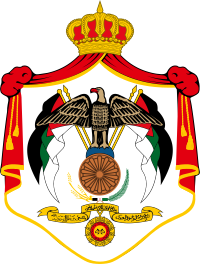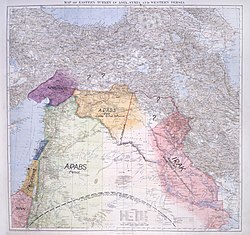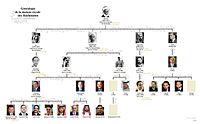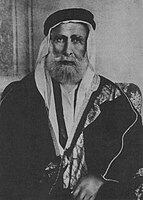Hashemites
| House of Hashim الهاشميون Hashemites | |
|---|---|
 Hashemite Banner | |
| Parent house | Dhawu Awn, a branch ofBanu Qatadah,ofBanu Hassan,ofBanu Hashim,ofQuraysh |
| Country |
|
| Founded | |
| Founder | Hussein bin Ali |
| Current head | |
| Final ruler | |
| Titles | |
| Estate(s) | Cf.Hashemite custodianship of Jerusalem holy sites |
| Deposition |
|
 |
|---|
|
|
|
|
| Historical Arab states and dynasties |
|---|
 |
TheHashemites(Arabic:الهاشميون,romanized:al-Hāshimiyyūn), alsoHouse of Hashim,are theroyal familyofJordan,which they have ruled since 1921, and were the royal family of the kingdoms ofHejaz(1916–1925),Syria(1920), andIraq(1921–1958). The family had ruled the city ofMeccacontinuously from the 10th century, frequently asvassalsof outside powers, and ruled the thrones of the Hejaz, Syria, Iraq, and Jordan following theirWorld War Ialliance with theBritish Empire.
The family belongs to the Dhawu Awn, one of the branches of theḤasanidSharifs of Mecca,also referred to as Hashemites.[1]Their eponymous ancestor is traditionally considered to beHashim ibn Abd Manaf,great-grandfather of theIslamic prophetMuhammad.The Ḥasanid Sharifs of Mecca (from whom the Hashemite royal family is directly descended), including the Hashemites' ancestorQatadah ibn Idris,[2]wereZaydīShīʿasuntil the lateMamlukor earlyOttomanperiod, when they became followers of theShāfiʿī schoolofSunnī Islam.[3]
The current dynasty was founded bySharif Hussein ibn Ali,who was appointed asSharif and Emir of Meccaby the Ottoman sultanAbdul Hamid IIin 1908, then in 1916—after concluding asecret agreement with the British Empire—was proclaimed King of Arab countries (but only recognized as King of the Hejaz) after initiating theArab Revoltagainst theOttoman Empire.His sonsAbdullahandFaisalassumed the thrones of Jordan and Iraq in 1921, and his first sonAlisucceeded him in the Hejaz in 1924. This arrangement became known as the "Sharifian solution".Abdullahwas assassinatedin 1951, but his descendantscontinue to rule Jordantoday. The other two branches of the dynasty did not survive; Aliwas oustedbyIbn Saudafter the British withdrew their support from Hussein in 1924–1925, and Faisal's grandsonFaisal IIwas executed in the1958 Iraqi coup d'état.
History
[edit]Rulers of Mecca
[edit]According to historiansIbn KhaldunandIbn Hazm,inc. 968Ja'far ibn Muhammad al-Hasanicame fromMedinaand conqueredMeccain the name of theFatimidcaliphal-Mu'izz,after the latter hadconquered Egyptfrom theIkhshidids.[4][5]Jafar was from the widerBanu Hashimclan, albeit a different branch to the modern dynasty. The Banu Hashim claim to trace their ancestry fromHashim ibn Abd Manaf(died c. 497 CE), the great-grandfather ofMuhammad,although the definition today mainly refers to the descendants of Muhammad's daughterFatimah.[6]
Control of Mecca remained with the clan; when theOttoman Turks took control of Egyptin 1517, Sharif Barakat quickly recognized the change in sovereignty, sending his sonAbu Numayy IIto theOttoman sultanSelim Iin Cairo, bearing the keys to the holy cities and other gifts. The Ottoman sultan confirmed Barakat and Abu Numayy in their positions as co-rulers of the Hejaz.[7][8][9]
World War I and the Arab Revolt
[edit]Before World War I,Hussein bin Aliof the Hashemite Dhawu-'Awn clan ruled the Hejaz on behalf of theOttomansultan. For some time it had been the practice of theSublime Porteto appoint theEmir of Meccafrom among a select group of candidates. In 1908, Hussein bin Ali was appointed to theSharifate of Mecca.He found himself increasingly at odds with theYoung Turksin control atIstanbul,while he strove to secure his family's position as hereditary emirs. Hussein bin Ali's lineage and destined position as theSharif of Meccahelped foster the ambition for an independent Arab kingdom and caliphate. These pretensions came to the Ottoman rulers' attention and caused them to "invite" Hussein to Istanbul as the guest of the sultan in order to keep him under direct supervision. Hussein brought his four sons, Ali, Abdullah, Faisal, and Zeid, with him. It was not until after theYoung Turk Revolutionthat he was able to return to theHijazand was officially appointed the Sharif.
Of Hussein's four sons, Abdullah was the most politically ambitious and became the planner and driving force behind the Arab revolt. Abdullah received military training in both the Hijaz and Istanbul. He was the deputy for Mecca in the Ottoman Parliament between 1912 and 1914. During this period, Abdullah developed deep interest in Arab nationalism and linked his father's interest for autonomous rule in the Hijaz to complete Arab emancipation.[10]In 1914 he met the British high commissioner,Lord Kitchener,in Cairo to discuss the possibility of the British supporting an Arab uprising against the Turks. The possibility of co-operation was raised but no commitment was made by either side. Shortly after Abdullah returned to Mecca, he became his father's foreign minister, political advisor, and one of the commanders of the Arab Revolt.
Faisal, Hussein's third son, played an active role in the revolt as commander of the Arab army, while the overall leadership was placed in the hands of his father. The idea of an Arab uprising against the Ottoman Empire was first conceived by Abdullah.[11]Only after gradual and persistent nudging did Abdullah convince his father, the conservative Sharif of Mecca, to move from the idea of home rule of a portion of Arabia within the Ottoman Empire to complete and total independence of the entire Empire's Arab provinces. Hussein recognized the necessity of breaking away from the Empire in the beginning of 1914 when he realized that he would not be able to complete his political objectives within the framework of the Ottomans. To have any success with the Arab revolt, the backing of another great power was crucial.
Hussein regarded Arab unity as synonymous with his own kingship. He aspired to have the entireArabian Peninsula,theregion of Syria,andIraqunder his – and his descendants' – rule. After a year of fruitless negotiation, SirHenry McMahonconveyed the British government's agreement to recognize Arab independence over an area that was much more limited than that to which Hussein had aspired. The Arab revolt, an Anglo-Hashemite plot in its essence, broke out in June 1916. Britain financed the revolt and supplied arms, provisions, direct artillery support, and experts in desert warfare including the soon to be famousT. E. Lawrence.The Hashemites promised more than they were able to deliver, and their ambitious plan collapsed. There were only a small number of Syrian and Iraqi nationalists who joined under the Sharifan banner while others remained loyal to the Ottoman sultan.
Sharif Hussein bin Ali rebelled against the rule of the Ottomans during theArab Revoltof 1916.[12]For Hashemite contribution to the Allied forces effort to bring down the Ottoman Empire, Britain promised its support for Arab independence. However, theMcMahon–Hussein correspondenceleft territorial limits governing this promise obscurely defined leading to a long and bitter disagreement between the two sides.
-
Hussein bin Ali, Sharif of Mecca(1853–1931), the founder of the modern dynasty
-
King Faisal I of Iraq and King Ali of Hejaz
-
Hashemites family tree
Post-War: the Sharifian Solution
[edit]

After the war, the British devised a "Sharifian Solution"to" [make] straight all the tangle "of their various wartime commitments.[14]This proposed that three sons of Sharif Hussein would be installed as kings of newly created countries across the Middle East.[15]
Given the need to rein in expenditure and factors outside British control, including France'sremoving of Faisal from Syria in July 1920,andAbdullah's entry into Transjordan(which had been the southern part of Faisal's Syria) in November 1920, the eventual Sharifian solution was somewhat different, the informal name for a British policy put into effect bySecretary of State for the ColoniesWinston Churchillfollowing the 1921Cairo conference.[16][17]




Hussein bin Ali had five sons:
- Ali,who briefly succeeded to the throne of Hejaz before its loss to theSaud familyin 1925.
- Abdullah,became the emir ofTransjordanin 1921 and king ofJordanin 1946, and whosedescendantscontinue to rule the kingdom known ever since as theHashemite Kingdom of Jordan.
- Faisal,briefly proclaimed King of theArab Kingdom of Syriain 1920, becameKing of Iraqin 1921.
- Prince Zeid bin Hussein,who moved to Jordan when his brother's grandson, KingFaisal II of Iraq,was overthrown and murdered in acoup in 1958.
- Hassan, died at a young age.
Hussein bin Ali continued to rule an independent Hejaz, of which he proclaimed himself king, between 1916 and 1924, after the collapse of Ottoman power, with the tacit support of the BritishForeign Office.His supporters are sometimes referred to as "Sharifians" or the "Sharifian party". Hussein bin Ali's chief rival in the Arabian Peninsula, the king of theNajd(highlands),Ibn Saud,annexed the Hejaz in 1925 and established his own son,Faysal bin Abdulaziz Al Saud,as governor. The region was later incorporated intoSaudi Arabia.
InTransjordan,the British governmentgranted its independence in 1921with Abdullah as ruler. The degree of independence that was afforded to the Arab states by colonial powers was an ongoing issue at the time, however in the case of Transjordan, the independence enjoyed was limited; with substantial influence and control reserved byBritish governmentin London. In domestic affairs the local ruler was given a considerable amount of power nonetheless; but these powers were exercised in an autocratic manner by the Hashemite family while remaining under the superintendence of theBritish ResidentinAmman,as well as the Britishhigh commissionerin Jerusalem.[18]Abdullahwas assassinatedin 1951, but his descendantscontinue to rule Jordantoday.
In Iraq, the Hashemites ruled for almost four decades, until Faisal's grandsonFaisal IIwas executed in the1958 Iraqi coup d'état.
Members and family tree
[edit]Ancestry
[edit]Jordanian main branch
[edit]- The KingandQueen(The monarch and his wife)
- The Crown PrinceandPrincess Rajwa(The King's elder son and daughter-in-law)
- Princess Imanand Jameel Alexander Thermiótis (The King's elder daughter and son-in-law)
- Princess Salma(The King's younger daughter)
- Prince Hashem(The King's younger son)
Descendants of King Hussein of Jordan
[edit]- Queen Noor(King Hussein's fourth wife and widow)
- HamzahandPrincess Basmah(The King's half-brother and half-sister-in-law)
- Princess Haya (The King's half-niece)
- Princess Zein (The King's half-niece)
- Princess Noor (The King's half-niece)
- Princess Badiya (The King's half-niece)
- Prince Hussein (The King's half-nephew)
- Prince Muhammad (The King's half-nephew)
- Prince Hashimand Princess Fahdah (The King's half-brother and half-sister-in-law)
- Princess Haalah (The King's half-niece)
- Princess Rayet (The King's half-niece)
- Princess Fatima (The King's half-niece)
- Prince Hussein (The King's half-nephew)
- Prince Mohammad (The King's half-nephew)
- Princess Iman(The King's half-sister)
- Princess Raiyah(The King's half-sister)
- Princess Haya(The King's half-sister)
- Prince AliandPrincess Rym(The King's half-brother and half-sister-in-law)
- Princess Jalila (The King's half-niece)
- Prince Abdullah (The King's half-nephew)
- HamzahandPrincess Basmah(The King's half-brother and half-sister-in-law)
- Princess Muna(King Hussein's second wife; The King's mother)
- Prince Faisaland Princess Zeina (The King's brother and sister-in-law)
- Princess Ayah(The King's niece)
- Prince Omar(The King's nephew)
- Princess Sara(The King's niece)
- Princess Aisha(The King's niece)
- Prince Abdullah (The King's nephew)
- Prince Muhammad (The King's nephew)
- Princess Rajaa (The King’s niece)
- Princess Alia(The King's former sister-in-law)
- Princess Aisha(The King's sister)
- Princess Zein(The King's sister)
- Princess Alia(The King's half-sister)
- Prince Faisaland Princess Zeina (The King's brother and sister-in-law)
Descendants of King Talal of Jordan
[edit]- Princess Taghrid (The King's aunt)
- Prince TalalandPrincess Ghida(The King's cousin and cousin-in-law)
- Prince Hussein (The King's first cousin once removed)
- Prince Muhammad (The King's first cousin once removed)
- Princess Rajaa (The King's first cousin once removed)
- Prince GhaziandPrincess Miriam(The King's cousin and cousin-in-law)
- Princess Tasneem (The King's first cousin once removed)
- Prince Abdullah (The King's first cousin once removed)
- Princess Jennah (The King's first cousin once removed)
- Princess Salsabil (The King's first cousin once removed)
- Prince TalalandPrincess Ghida(The King's cousin and cousin-in-law)
- Princess Firyal(The King's former aunt)
- Prince HassanandPrincess Sarvath(The King's uncle and aunt)
- Princess Rahma(The King's cousin)
- Princess Sumaya(The King's cousin)
- Princess Badiya(The King's cousin)
- Prince RashidandPrincess Zeina(The King's cousin and cousin-in-law)
- Prince Hassan (The King's first cousin once removed)
- Prince Talal (The King's first cousin once removed)
- Princess Basma(The King's aunt)
Descendants of King Abdullah I of Jordan
[edit]- Prince Ali and Princess Reema (The King's cousin and cousin-in-law)
- Prince Muhammad and Princess Sima (The King's second cousin and his wife)
- Prince Hamzah (The King's second cousin)
- Princess Rania (The King's second cousin)
- Princess Karma (The King's second cousin)
- Prince Haidar (The King's second cousin)
- Princess Na'afa (The King's second cousin)
- Princess Rajwa (The King's second cousin)
- Princess Basma Fatima (The King's second cousin)
- Prince Muhammad and Princess Sima (The King's second cousin and his wife)
- Prince AsemandPrincess Sana(The King's cousin and cousin-in-law)
- Princess Yasmine (The King's second cousin)
- Princess Sara(The King's second cousin)
- Princess Noor(The King's second cousin)
- Princess Salha(The King's second cousin)
- Princess Nejla(The King's second cousin)
- Prince Nayef and Princess Farah (The King's second cousin and his wife)
- Prince Nayef (The King's second cousin)
- Princess Naifeh (The King's grandaunt)
Iraqi Hashemites (Descendants of Prince Ra'ad ibn Zaid)
[edit]The descendants of Iraqi Hashemite princeRa'ad ibn Zaidhave been awarded Jordanian citizenship and are addressed in the style of His Royal Highness and Prince in Jordan. Descendants includePrince Zeid bin Ra'ad,a Jordanian diplomat, who served as United Nations High Commissioner for Human Rights from 2014 to 2018, andPrince Mired bin Ra'ad.
Non-royals
[edit]A number of Dhawu Awn clansmen migrated with EmirAbdullah ItoTransjordanin the early 1920s. Several of their descendants have gained prominent positions in the Jordanian state, including the positions of Chief of the Royal Court, Prime Minister, and Ambassador. Descendants of the Dhawu Awn clansmen are referred to asSharifsand, other than Zaid ibn Shaker, have not been awarded princely title. Examples include former Prime Ministers and Royal Court ChiefsSharif Hussein ibn Nasser,[21]Sharif Abdelhamid Sharaf,[22]Queen Zein Al-Sharaf(wife ofKing Talaland mother of KingHussein) and her brother Sharif Nasser bin Jamil.[23]
Princely title in Jordan is typically restricted only to patrilineal descendants of any of the four sons ofHussein bin Ali, Sharif of Mecca.
Sharif Ali bin al-Husseinwas the leader of theIraqi Constitutional Monarchy political partyand currently uses the title "Sharif".
Queen Dina Abdul-Hamidalso was a member of the House of Hashim. She was entitled to use the honorific titlesharifaofMeccaas anagnatic descendantofHasan ibn Ali,the grandson ofMuhammad.
Descendants of Prince Zaid ibn Shaker
[edit]PrinceZaid ibn Shaker,former PM and Commander-in-chief of the Jordanian military, was a member of the Dhawu Awn clan whose father Shaker ibn Zaid migrated to Transjordan with his cousinAbdullah I of Jordan.He was awarded the non-hereditary title of "prince" in 1996. His children, one son and one daughter, are addressed as "Sharifs" – not princes.[24]
See also
[edit]- Hashemite custodianship of Jerusalem holy sites
- Royal and Hashemite Order of the Pearl(Sulu, Philippines)
- Succession to the Jordanian throne
Citations
[edit]- ^"The Hashemites".King Abdullah II Official Website.Retrieved2019-08-29.
- ^Curatola, Giovanni (2007).The Art and Architecture of Mesopotamia.Abbeville Press.ISBN978-0-7892-0921-4.
- ^"Shiʿites in Arabia".Encyclopædia Iranica.Retrieved2019-08-29.
The Zaydi denomination of the (Ḥasanid) Sharifian rulers of Mecca and the Imāmi-Shiʿi leanings of the (Ḥosaynid) emirs of Medina were well known to medieval Sunni and Shiʿi observers. This situation gradually changed under Mamluk rule (for the development over several centuries, up to the end of the Mamluk period, see articles by Mortel mentioned in the bibliography below). A number of Shiʿite and Sunnite sources hint at (alleged or real) sympathy for the Shiʿa among the Hāshemite (officially Sunni) families of the Ḥejāz, or at least some of their members
- ^Ibn Fahd, ‘Izz al-Dīn ‘Abd al-‘Azīz ibn ‘Umar ibn Muḥammad (1986) [composed before 1518]. Shaltūt, Fahīm Muḥammad (ed.).Ghāyat al-marām bi-akhbār salṭanat al-Balad al-Ḥarāmغاية المرام بأخبار سلطنة البلد الحرام(in Arabic). Vol. 1 (1st ed.). Makkah: Jāmi‘at Umm al-Qurá, Markaz al-Baḥth al-‘Ilmī wa-Iḥyā’ al-Turāth al-Islāmī, Kullīyat al-Sharīʻah wa-al-Dirāsāt al-Islāmīyah. pp. 480–482.
- ^Teitelbaum 2001,p. 9.
- ^Lawrence 2000,p. 48.
- ^al-Sibā‘ī 1999,pp. 393–394.
- ^Uzunçarşılı 2003,p. 133.
- ^Daḥlan 2007,p. 124.
- ^Shlaim 1988,p. 20.
- ^Shlaim 1988,p. 22.
- ^Lawrence 2000,p. 53.
- ^"Lawrence's Mid-East map on show".BBC News.11 October 2005.Archivedfrom the original on 3 December 2006.
- ^Arab Awakening.Taylor & Francis. 19 December 2013. pp. 303–.ISBN978-1-317-84769-4.
- ^Paris 2004,p. 50.
- ^Rogan, Eugene L. (2016)."The Emergence of the Middle East into the Modern State System".In Fawcett, Louise (ed.).International relations of the Middle east.Oxford University Press. p. 50.ISBN978-0-19-870874-2.
- ^Paris 2004,p. 246.
- ^Shlaim 1988,p. 37.
- ^Salibi, Kamal (1998).A Modern History of Hashemite Kingdom.I.B.Tauris.ISBN978-1-86064-331-6.
- ^شجرة النسب الشريف[Hashemite Ancestry].alhussein.gov(in Arabic). 1 January 2014.Retrieved8 February2018.
- ^رئاسة الوزراء - سيادة الشريف حسين بن ناصر[Prime Minister – Sharif Hussein bin Nasser].www.pm.gov.jo(in Arabic).
- ^"Monday marks 37th death anniversary of former PM Sharaf".Jordan Times.July 2, 2017.
- ^"Prince Sharif Jamil bin Nasser".Arab Revolt Centennial.Retrieved2019-08-29.
- ^سمو الامير زيد بن شاكر[His Highness Prince Zaid Bin Shake].www.pm.gov.jo(in Arabic). 2014-04-23.Retrieved2019-08-29.
Bibliography
[edit]- al-Sibā‘ī, Aḥmad ibn Muḥammad Aḥmad (1999) [1419 AH (1998/1999)].Tārīkh Makkahتاريخ مكة(in Arabic). al-Amānah al-‘āmah lil-iḥtifāl bi murūr mi’ah ‘ām ‘alá ta’sīs al-Mamlakah al-‘Arabīyah al-Su‘ūdīyah.
- Allawi, Ali A.(2014).Faisal I of Iraq.Yale University Press. pp. 1–.ISBN978-0-300-19936-9.
- Daḥlan, Aḥmad Zaynī (2007) [1887/1888].Khulāṣat al-kalām fī bayān umarā' al-Balad al-Ḥarāmخلاصة الكلام في بيان أمراء البلد الحرام(in Arabic). Dār Arḍ al-Ḥaramayn.
- Lawrence, T. E.(2000).Seven Pillars of Wisdom.Penguin Books Limited.ISBN978-0-14-119208-6.
- McNamara, Robert (2010).The Hashemites: The Dream of Arabia.Haus Publishing.ISBN978-1-907822-35-3.
- Paris, Timothy J. (23 November 2004).Britain, the Hashemites and Arab Rule: The Sherifian Solution.Routledge.ISBN978-1-135-77191-1.
- Rudd, Jeffery A. (1993).Abdallah bin al-Husayn: The Making of an Arab Political Leader, 1908–1921(PDF)(PhD). SOAS Research Online. pp. 45–46.Retrieved12 June2019.
- Shlaim, Avi (1988).Collusion across the Jordan: King Abdullah, the Zionist movement and the partition of Palestine.Clarendon.ISBN978-0-19-827831-3.
- Strovolidou, Emilia."A young Palestinian law student's long journey to integration".Cyprus: UNHCR.
- Teitelbaum, Joshua (2001).The Rise and Fall of the Hashimite Kingdom of Arabia.C. Hurst & Co. Publishers.ISBN9781850654605.
- Uzunçarşılı, İsmail Hakkı (2003).Ashrāf Makkat al-Mukarramah wa-umarāʼihā fī al-ʻahd al-ʻUthmānīأشراف مكة المكرمة وأمرائها في العهد العثماني(in Arabic). Translated by Murād, Khalīl ʻAlī (1st ed.). Beirut: al-Dār al-‘Arabīyah lil-Mawsū‘āt.
External links
[edit] Media related toHashemitesat Wikimedia Commons
Media related toHashemitesat Wikimedia Commons



